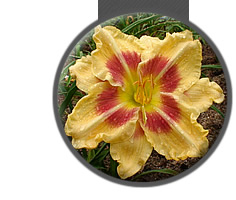
POLYMEROUS vs. POLYTEPAL
In 1995, the American Hemerocallis Society recognized a new classification of daylilies and called them "polytepals." This term was botanically incorrect. At the fall 2008 meeting of the AHS Board of Directors correctly changed the term to "polymerous."
As a leading advocate of this new form of Hemerocallis, I urge all daylily growers and hybridizers to use the term "polymerous" for flowers that are syntepalous, i.e., those that have four or more segments in each whorl that are joined at the base, forming the perianth tube as in daylilies.
The term "polytepalous" refers to multiple flower segments
that are completely separate from each other, which is not the case in Hemerocallis.
Additional Polymerous Terms
tetramerous = 4 per whorl ; a tetramer
pentamerous = 5 per whorl; a pentamer
hexamerous = 6 per whorl; a hexamer

Bobby Baxter
Happy Moose Gardens
|
Hemerocallis ‘Forsyth Tepaled Double’

Hemerocallis ‘Forsyth Tepaled Double’
Lefever, 1998
| Description: 60% Polymerous. Pink with rose eye and bright green throat which doubles 90%. |
| Bloom: 4.5 inches, 11.43 cm Height: 18 inches, 45.72 cm |
| Diploid: Yes Tetraploid: No Foliage: evergreen |
| Season: M Rebloom: No Bloom: diurnal Fragrance: fragrant |
| Parentage: (Forsyth Hot Lips × Nagasaki) |
| Spider: No Ratio: 0:1 Length: 0", 0 cm Width: 0", 0 cm |
| Unusual Form: No UF Type: |
| Double: No Percentage: 0% |
| Cultivar Comments: |
| Cultivar Change of Status: |
Previous Page
|